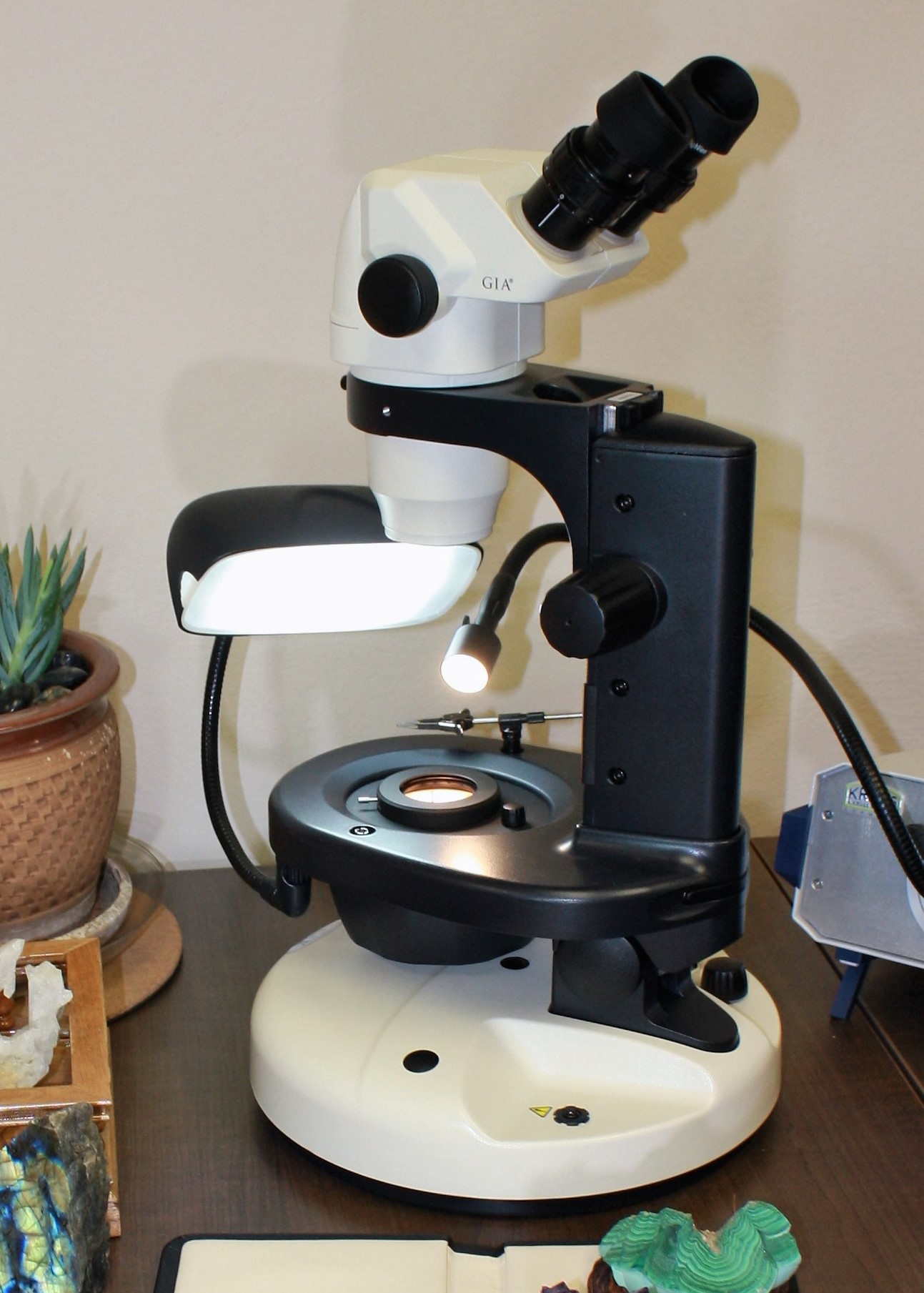Tools of the Trade.
About this section
This section is designed to give you a brief glimpse into what types of identification tests and analysis procedures your items will potentially undergo while in the appraisal process.
A gemologist and jewelry appraiser uses various types of equipment to assist in identifying unknown gemstones, to establish grades, to pick out manufacturing details of jewelry and timepieces, as well as to inspect items for potential damage or wear and tear.

The Binocular Microscope: A Gemologist/Appraiser’s Best Friend
A modern gemological microscope is the “go-to” tool in an appraiser’s repertoire of equipment.
It is equipped with very high-grade lenses, sophisticated illumination capabilities, and the ability to zoom from approximately 7x magnification to as much as 60x or higher.
A good microscope opens up a whole new world of information for the trained gemologist. It allows one to see the inner structure and growth characteristics of minerals and to see minute features that can be key to the identification of an unknown gemstone. Physical features of gemstones are much like the grain in wood, or a fingerprint, in that they are very unique to each gemstone and serve to allow you to identify your own products as well as being integral to the technical grading process and eventual assessment of value. If you have never seen the diamond in your engagement ring, for example, in a microscope, you should! It is easy, fun, very informative, and you’ll come away with a greatly enhanced understanding and appreciation for your own items.
The microscope also allows the appraiser to view jewelry items very closely and to determine its structural integrity. Jewelry items are commonly worn extensively for many, many years and the cumulative effect of all that wear takes a toll on the metals and gemstones. Sometimes that’s not so easy to see and it only becomes apparent when a stone falls out or major structural failure takes place. By having your jewelry items inspected closely, you can have simple preventative maintenance performed which will, in turn, extend their lifetimes by many times over and allow multiple generations to enjoy the same items.
The Refractometer: Measuring a Gem’s Optical Fingerprint
A refractometer is a very sensitive piece of equipment that allows a gemologist to measure what is known as the “refractive index” of a gemstone.
A refractive index (“RI”) is a measurement of how fast light passes through one medium as opposed to how it passes through another. In the case of gemstones, it is a measurement of how fast light passes through the gemstone as compared to how it passes through space. For example: Diamond has a refractive index of 2.42. This means that light passes through diamond 2.42 times SLOWER than it does though space. It is an extremely helpful piece of information to know as it is one of the traits or characteristics that is highly individualistic for most gemstones…nearly diagnostic at times…and can greatly aid the gemologist in the determination of an unknown stone’s identity.
Unfortunately, many stones are set into mountings which prevent a refractive index test from being performed. The mountings get in the way and prevent the necessary physical contact that must be made between the gemstone and the refractometer. When this happens, the gemologist must resort to other skills and equipment to determine the identity of the unknown stone. But, when an “RI” can be determined, it makes the gemologist’s life a LOT easier.


The Spectroscope: Measuring the Absorption or Transmission of Wavelengths of Light
The human eye and brain are teammates in the processing, analyzation, and defining of light. As we all know, light is a form of radiant energy. We commonly refer to the “visible spectrum” as the “rainbow colors”. There is also what we refer to as “white” and “black” which are really not colors, in and of themselves, but rather are a complete mixture of all the colors of the spectrum (white) and the complete LACK of the colors of the spectrum (black). There are other forms of radiant energy which we can’t see such as X-rays, gamma rays, ultra-violet, infrared and so forth.
When light strikes an object, that object generally absorbs some wavelengths of light and transmits or reflects others. The light wavelengths that are absorbed never make it to our eye and, as a result, we don’t perceive them. The wavelengths that ARE transmitted or reflected DO make it to our eyes and, in turn, are handed off to the brain for analysis. Thus, when we look at a nice ripe tomato, it looks “red” …or some variation of it. That’s because the tomato is “transmitting” wavelengths of light that fall, primarily, in the red zone. It may well also be modified by wavelengths in other zones which is why we may well perceive several different variants of “red” in the same tomato. The human eye/brain team is generally capable of processing over a million variations of colors, intensities, tone, and saturation levels.
A spectroscope measures what wavelengths of light are being absorbed by a gemstone and which ones are being transmitted. This could be effectively described as “optical DNA” as it can be absolutely diagnostic in the identification of an unknown gemstone. Each variety of gemstone has its own characteristic “spectra” and it can be so individualistic as to even determine the origin of the stone…meaning what hole in the ground it came from! The spectroscope can also help to determine if a stone has been treated or “enhanced” as the process used to alter a gemstone also alter its spectra.
Using a spectroscope can be difficult at times. To observe a gem’s “spectra” it is necessary to have light pass through it in a very specific manner and at very specific angles. Sometimes, this is nearly impossible, especially if the stone is mounted in a piece of jewelry.
